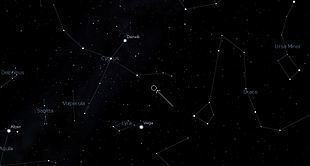Luminosity (bolometric) 0.8 L☉ | Luminosity (visual, LV) ~0.67 L☉ Apparent magnitude (V) 11.664 | |
 | ||
Similar Kepler‑11, Kepler‑186, Kepler‑42, Kepler‑16, Kepler‑69 | ||
The promise of kepler 22b
Kepler-22 is a star in the northern constellation of Cygnus, the swan, that is orbited by a planet found to be unequivocally within the star's habitable zone. It is located at the celestial coordinates: Right Ascension 19h 16m 52.2s, Declination +47° 53′ 4.2″. With an apparent visual magnitude of 11.7, this star is too faint to be seen with the naked eye. It can be viewed with a telescope having an aperture of at least 4 in (10 cm). The estimated distance to Kepler-22 is 620 light-years (190 parsecs).
Contents
- The promise of kepler 22b
- Kepler 22b first confirmed earth like planet orbiting sun like star in habitable zone
- Planetary system
- References
Kepler-22 is slightly smaller and cooler than the Sun, with a lower abundance of elements having more mass than helium. It has a spectral type of G5, while the luminosity class remains undetermined. This star is radiating 79% of the Sun's luminosity from its outer atmosphere at an effective temperature of 5,518 K, giving it the yellow-hued glow of a G-type star. A projected rotational velocity of 0.6 km/s suggests it has a low period of rotation.
Kepler 22b first confirmed earth like planet orbiting sun like star in habitable zone
Planetary system
On December 5, 2011, scientists from the Kepler mission announced that a possible Earthlike world (Kepler-22b) had been discovered orbiting in the star's habitable zone by NASA's Kepler spacecraft. This was significant in that it was the first relatively Earth-sized extrasolar planet (about twice as big) confirmed to be orbiting within a star's habitable zone.
